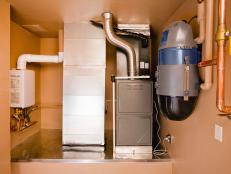Why R-Values Matter in Energy Efficiency
R-value measures the ability to prevent the transfer of heat; the larger the number, the harder that insulation is working at preventing heat conduction.
When we talk of insulation, the term R-value inevitably enters the conversation. A wall is R-19, a roof is R-30 — what does this mean?
Essentially R-value is a measure of thermal resistance, or the ability to prevent the transfer of heat. The larger the number, the harder that insulation is working at preventing heat conduction. The less heat loss, the lower your energy bills.
Jeff Wilson, who is retrofitting his 70-year-old home in Athens, Ohio, explains R-value like this: "Say you took a blow torch and lit it against a piece of tin foil. If you touched the other side of that foil, it would be hot. If you put that blow torch against wall board and touched the other side of the board, it would get warm, but it would not get hot quickly." The wall board has a higher R-value than the tin foil because it provides a better thermal break.
So how much R-value is enough — and what is considered energy efficient? Jeff says the majority of U.S. homes were constructed with 3x4 walls and filled with R-13 insulation. Newer, smarter standards are 2x6 walls (a larger cavity provides more room for a thicker thermal barrier) with R-19 insulation. The standard R-value for roofs is R-30 or R-40.
How Heat Transfers
A quick science lesson helps explain how heat transfer can sabotage a home's energy efficiency, and what you can do to stop it. Heat moves in three ways: conduction, convection or radiation.
R-value addresses conduction: the transfer of heat through a material (your walls).
Convection occurs when heat and moisture move, and this happens when a home's envelope — siding, sheathing, walls — are not tight. Convection issues are solved by air-sealing a home.
"Unfortunately, most homes are leaky and have holes on the outside shell," Jeff says. "If air can pass through the cavity to where the insulation is, there are two main problems: You're convectively moving heat, and also sucking moisture in, which tends to condense and form mildew inside wall cavities."
Radiation is when heat flows from a hotter material to a cooler one. For example, black roofing attracts heat and transfers it into the attic. Jeff addresses this with radiant sheathing that deflects heat from the home.
The take-away Jeff emphasizes: While a higher R-value is important for providing a thermal barrier (preventing conduction), it does not address radiation or convection. Only by air-sealing the home, improving insulation and addressing radiant heat on the roof can a home reach optimum energy efficiency.
Upping Your R-Value
Insulating your home will improve its R-value and help conserve energy, regardless of other air-sealing efforts you make. Every little bit helps.
Choose insulation. The most common types of insulation on the market today are fiberglass batting, cellulose (paper fiber) and foam board. Foam board provides higher R-values but tends to cost quite a bit more. "Ideally you apply [foam board] on the outside surface, which is difficult for most people because their homes have siding or brick — an impediment for installation," Wilson says. Spray foam is more readily available today in do-it-yourself kits.
Aim for high standards. Generally speaking, walls should be R-19 and the roof should be R-30 or R-40, Jeff says. You can kick that up and shoot for standards set by the Passive House Institute US — R-30 walls and an R-60 roof.
Think beyond R-value. As you explore ways to tighten your home and prevent heat transfer of all kinds, improve the building envelope with more secure siding and better roofing that will prevent convection and radiation.






































